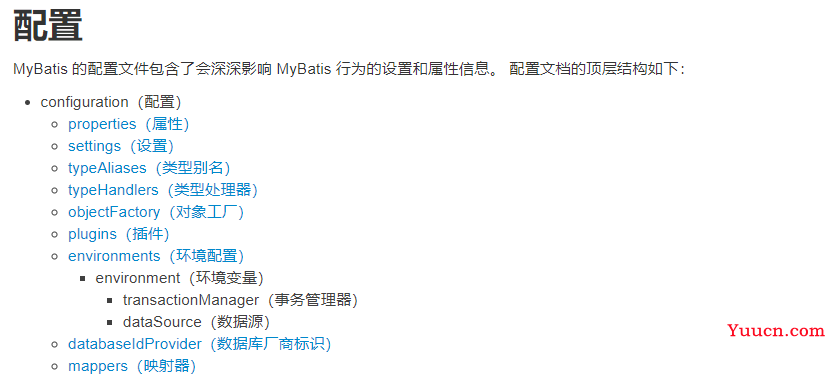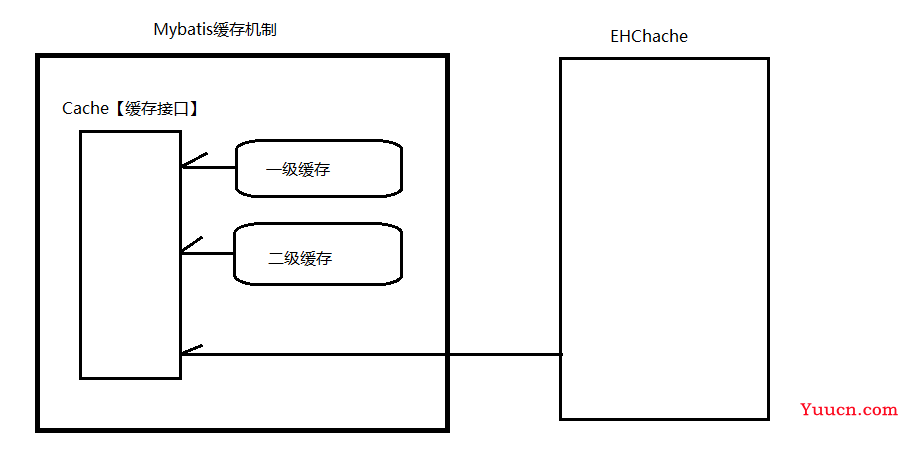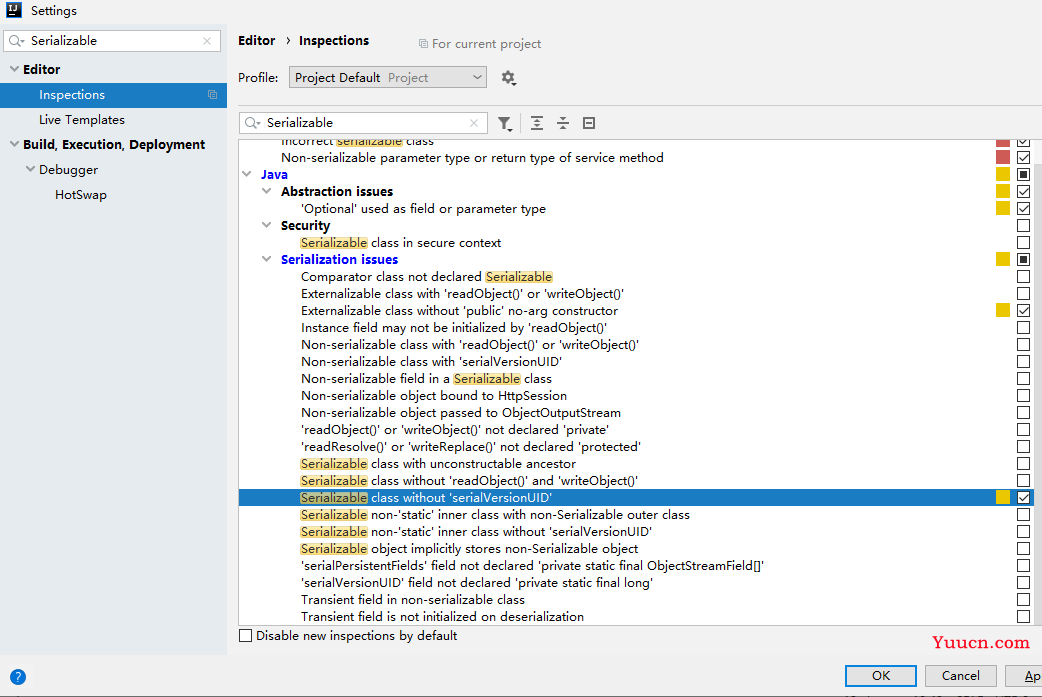第一章 初识Mybatis
1.1 框架概述
-
生活中“框架”
- 买房子
- 笔记本电脑
-
程序中框架【代码半成品】
- Mybatis框架:持久化层框架【dao层】
- SpringMVC框架:控制层框架【Servlet层】
- Spring框架:全能...
1.2 Mybatis简介
-
Mybatis是一个半自动化持久化层ORM框架
-
ORM:Object Relational Mapping【对象 关系 映射】
- 将Java中的对象与数据库中表建议映射关系,优势:操作Java中的对象,就可以影响数据库中表的数据
-
Mybatis与Hibernate对比
- Mybatis是一个半自动化【需要手写SQL】
- Hibernate是全自动化【无需手写SQL】
-
Mybatis与JDBC对比
- JDBC中的SQL与Java代码耦合度高
- Mybatis将SQL与Java代码解耦
-
Java POJO(Plain Old Java Objects,普通老式 Java 对象)
- JavaBean 等同于 POJO
1.3 官网地址
- 文档地址:https://mybatis.org/mybatis-3/
- 源码地址:https://github.com/mybatis/mybatis-3
第二章 搭建Mybatis框架
导入jar包
编写配置文件
使用核心类库
2.1 准备
- 建库建表建约束
- 准备maven工程
2.2 搭建Mybatis框架步骤
-
导入jar包
<!--导入MySQL的驱动包--> <dependency> <groupId>mysql</groupId> <artifactId>mysql-connector-java</artifactId> <version>5.1.37</version> </dependency> <!-- https://mvnrepository.com/artifact/mysql/mysql-connector-java --> <dependency> <groupId>mysql</groupId> <artifactId>mysql-connector-java</artifactId> <version>8.0.26</version> </dependency> <!--导入MyBatis的jar包--> <dependency> <groupId>org.mybatis</groupId> <artifactId>mybatis</artifactId> <version>3.5.6</version> </dependency> <!--junit--> <dependency> <groupId>junit</groupId> <artifactId>junit</artifactId> <version>4.12</version> <scope>test</scope> </dependency> -
编写核心配置文件【mybatis-config.xml】
-
位置:resources目标下
-
名称:推荐使用mybatis-config.xml
-
示例代码
<?xml version="1.0" encoding="UTF-8" ?> <!DOCTYPE configuration PUBLIC "-//mybatis.org//DTD Config 3.0//EN" "http://mybatis.org/dtd/mybatis-3-config.dtd"> <configuration> <environments default="development"> <environment id="development"> <transactionManager type="JDBC"/> <dataSource type="POOLED"> <!-- mysql8版本--> <!-- <property name="driver" value="com.mysql.cj.jdbc.Driver"/>--> <!-- <property name="url" value="jdbc:mysql://localhost:3306/db220106?serverTimezone=UTC"/>--> <!-- mysql5版本--> <property name="driver" value="com.mysql.jdbc.Driver"/> <property name="url" value="jdbc:mysql://localhost:3306/db220106"/> <property name="username" value="root"/> <property name="password" value="root"/> </dataSource> </environment> </environments> <!-- 设置映射文件路径--> <mappers> <mapper resource="mapper/EmployeeMapper.xml"/> </mappers> </configuration>
-
-
书写相关接口及映射文件
-
映射文件位置:resources/mapper
-
映射文件名称:XXXMapper.xml
-
映射文件作用:主要作用为Mapper接口书写Sql语句
- 映射文件名与接口名一致
- 映射文件namespace与接口全类名一致
- 映射文件SQL的Id与接口的方法名一致
-
示例代码
<?xml version="1.0" encoding="UTF-8" ?> <!DOCTYPE mapper PUBLIC "-//mybatis.org//DTD Mapper 3.0//EN" "http://mybatis.org/dtd/mybatis-3-mapper.dtd"> <mapper namespace="com.atguigu.mybatis.mapper.EmployeeMapper"> <select id="selectEmpById" resultType="com.atguigu.mybatis.pojo.Employee"> SELECT id, last_name, email, salary FROM tbl_employee WHERE id=#{empId} </select> </mapper>
-
-
测试【SqlSession】
- 先获取SqlSessionFactory对象
- 再获取SqlSession对象
- 通过SqlSession对象获取XXXMapper代理对象
- 测试
2.3 添加Log4j日志框架
-
导入jar包
<!-- log4j --> <dependency> <groupId>log4j</groupId> <artifactId>log4j</artifactId> <version>1.2.17</version> </dependency> -
编写配置文件
-
配置文件名称:log4j.xml
-
配置文件位置:resources
-
示例代码
<?xml version="1.0" encoding="UTF-8" ?> <!DOCTYPE log4j:configuration SYSTEM "log4j.dtd"> <log4j:configuration xmlns:log4j="http://jakarta.apache.org/log4j/"> <appender name="STDOUT" class="org.apache.log4j.ConsoleAppender"> <param name="Encoding" value="UTF-8" /> <layout class="org.apache.log4j.PatternLayout"> <param name="ConversionPattern" value="%-5p %d{MM-dd HH:mm:ss,SSS} %m (%F:%L) \n" /> </layout> </appender> <logger name="java.sql"> <level value="debug" /> </logger> <logger name="org.apache.ibatis"> <level value="info" /> </logger> <root> <level value="debug" /> <appender-ref ref="STDOUT" /> </root> </log4j:configuration>
-
第三章 Mybatis核心配置详解【mybatis-config.xml】
3.1 核心配置文件概述
- MyBatis 的配置文件包含了会深深影响 MyBatis 行为的设置和属性信息。
3.2 核心配置文件根标签
- 没有实际语义,主要作用:所有子标签均需要设置在跟标签内部
3.3 核心配置文件常用子标签
-
properties子标签
-
作用:定义或引入外部属性文件
-
示例代码
#key=value db.driver=com.mysql.jdbc.Driver db.url=jdbc:mysql://localhost:3306/db220106 db.username=root db.password=root<properties resource="db.properties"></properties> <environments default="development"> <environment id="development"> <transactionManager type="JDBC"/> <dataSource type="POOLED"> <!-- mysql8版本--> <!-- <property name="driver" value="com.mysql.cj.jdbc.Driver"/>--> <!-- <property name="url" value="jdbc:mysql://localhost:3306/db220106?serverTimezone=UTC"/>--> <!-- mysql5版本--> <property name="driver" value="${db.driver}"/> <property name="url" value="${db.url}"/> <property name="username" value="${db.username}"/> <property name="password" value="${db.password}"/> </dataSource> </environment> </environments>
-
-
settings子标签
-
作用:这是 MyBatis 中极为重要的调整设置,它们会改变 MyBatis 的运行时行为。
-
mapUnderscoreToCamelCase属性:是否开启驼峰命名自动映射,默认值false,如设置true会自动将
字段a_col与aCol属性自动映射
- 注意:只能将字母相同的字段与属性自动映射
-
-
类型别名(typeAliases)
-
作用:类型别名可为 Java 类型设置一个缩写名字。
-
语法及特点
<typeAliases> <!-- 为指定类型定义别名--> <!-- <typeAlias type="com.atguigu.mybatis.pojo.Employee" alias="employee"></typeAlias>--> <!-- 为指定包下所有的类定义别名 默认将类名作为别名,不区分大小写【推荐使用小写字母】 --> <package name="com.atguigu.mybatis.pojo"/> </typeAliases> -
Mybatis自定义别名
别名 类型 _int int integer或int Integer string String list或arraylist ArrayList map或hashmap HashMap
-
-
环境配置(environments)
-
作用:设置数据库连接环境
-
示例代码
<!-- 设置数据库连接环境--> <environments default="development"> <environment id="development"> <transactionManager type="JDBC"/> <dataSource type="POOLED"> <!-- mysql8版本--> <!-- <property name="driver" value="com.mysql.cj.jdbc.Driver"/>--> <!-- <property name="url" value="jdbc:mysql://localhost:3306/db220106?serverTimezone=UTC"/>--> <!-- mysql5版本--> <property name="driver" value="${db.driver}"/> <property name="url" value="${db.url}"/> <property name="username" value="${db.username}"/> <property name="password" value="${db.password}"/> </dataSource> </environment> </environments>
-
-
mappers子标签
-
作用:设置映射文件路径
-
示例代码
<!-- 设置映射文件路径--> <mappers> <mapper resource="mapper/EmployeeMapper.xml"/> <!-- 要求:接口的包名与映射文件的包名需要一致--> <!-- <package name="com.atguigu.mybatis.mapper"/>--> </mappers>
-
-
注意:核心配置中的子标签,是有顺序要求的。

第四章 Mybatis映射文件详解
4.1 映射文件概述
- MyBatis 的真正强大在于它的语句映射,这是它的魔力所在。
- 如果拿它跟具有相同功能的 JDBC 代码进行对比,你会立即发现省掉了将近 95% 的代码。
4.2 映射文件根标签
- mapper标签
- mapper中的namespace要求与接口的全类名一致
4.3 映射文件子标签
子标签共有9个,注意学习其中8大子标签
- insert标签:定义添加SQL
- delete标签:定义删除SQL
- update标签:定义修改SQL
- select标签:定义查询SQL
- sql标签:定义可重用的SQL语句块
- cache标签:设置当前命名空间的缓存配置
- cache-ref标签:设置其他命名空间的缓存配置
-
resultMap标签:描述如何从数据库结果集中加载对象
- resultType解决不了的问题,交个resultMap。
4.4 映射文件中常用属性
- resultType:设置期望结果集返回类型【全类名或别名】
- 注意:如果返回的是集合,那应该设置为集合包含的类型,而不是集合本身的类型。
- resultType 和 resultMap 之间只能同时使用一个。
4.5 获取主键自增数据
- useGeneratedKeys:启用主键生成策略
- keyProperty:设置存储属性值
4.6 获取数据库受影响行数
- 直接将接口中方法的返回值设置为int或boolean即可
- int:代表受影响行数
- boolean
- true:表示对数据库有影响
- false:表示对数据库无影响
第五章 Mybatis中参数传递问题
5.1 单个普通参数
- 可以任意使用:参数数据类型、参数名称不用考虑
5.2 多个普通参数
- Mybatis底层封装Map结构,封装key为param1、param2....【支持:arg0、arg1、...】
5.3 命名参数
-
语法:
- @Param(value="参数名")
- @Param("参数名")
-
位置:参数前面
-
注意:
- 底层封装Map结构
- 命名参数,依然支持参数【param1,param2,...】
-
示例代码
/** * 通过员工姓名及薪资查询员工信息【命名参数】 * @return */ public List<Employee> selectEmpByNamed(@Param("lName")String lastName, @Param("salary") double salary);<select id="selectEmpByNamed" resultType="employee"> SELECT id, last_name, email, salary FROM tbl_employee WHERE last_name=#{param1} AND salary=#{param2} </select> -
源码分析
-
MapperMethod对象:142行代码【命名参数底层代码入口】
-
命名参数底层封装map为ParamMap,ParamMap继承HashMap
-
ParamNameResolver对象:130行代码,命名参数底层实现逻辑
//130行 final Map<String, Object> param = new ParamMap<>(); int i = 0; for (Map.Entry<Integer, String> entry : names.entrySet()) { param.put(entry.getValue(), args[entry.getKey()]); // add generic param names (param1, param2, ...) final String genericParamName = GENERIC_NAME_PREFIX + (i + 1); // ensure not to overwrite parameter named with @Param if (!names.containsValue(genericParamName)) { param.put(genericParamName, args[entry.getKey()]); } i++; } return param;
-
5.4 POJO参数
- Mybatis支持POJO【JavaBean】入参,参数key是POJO中属性
5.5 Map参数
- Mybatis支持直接Map入参,map的key=参数key
5.6 Collection|List|Array等参数
- 参数名:collection、list、array
第六章 Mybatis参数传递【#与$区别】
6.1 回顾JDBC
- DriverManager
- Connection
- Statement:执行SQL语句,入参使用SQL【String】拼接方式
- PreparedStatement执行SQL语句【预编译SQL】,入参使用占位符方式
- ResultSet
6.2 #与$区别
- 【#】底层执行SQL语句的对象,使用PreparedStatementd,预编译SQL,防止SQL注入安全隐患,相对比较安全。
- 【$】底层执行SQL语句的对象使用Statement对象,未解决SQL注入安全隐患,相对不安全。
6.3 #与$使用场景
查询SQL:select col,col2 from table1 where col=? and col2=? group by ?, order by ? limit ?,?
-
使用场景,sql占位符位置均可以使用#
-
$使用场景,#解决不了的参数传递问题,均可以交给$处理【如:form 动态化表名】
/** * 测试$使用场景 */ public List<Employee> selectEmpByDynamitTable(@Param("tblName") String tblName);<select id="selectEmpByDynamitTable" resultType="employee"> SELECT id, last_name, email, salary FROM ${tblName} </select>
第七章 Mybatis查询中返回值四种情况
7.1 查询单行数据返回单个对象
/**
* 通过id获取员工信息
*/
public Employee selectEmpById(int empId);
<select id="selectEmpById" resultType="employee">
SELECT
id,
last_name,
email,
salary
FROM
tbl_employee
WHERE
id=#{empId}
</select>
7.2 查询多行数据返回对象的集合
/**
* 查询所有员工信息
*/
public List<Employee> selectAllEmps();
<select id="selectAllEmps" resultType="employee">
SELECT
id,
last_name,
email,
salary
FROM
tbl_employee
</select>
- 注意:如果返回的是集合,那应该设置为集合包含的类型,而不是集合本身的类型。
7.3 查询单行数据返回Map集合
-
Map<String key,Object value>
- 字段作为Map的key,查询结果作为Map的Value
-
示例代码
/** * 查询单行数据返回Map集合 * @return */ public Map<String,Object> selectEmpReturnMap(int empId);<!-- 查询单行数据返回Map集合--> <select id="selectEmpReturnMap" resultType="map"> SELECT id, last_name, email, salary FROM tbl_employee WHERE id=#{empId} </select>
7.4 查询多行数据返回Map集合
-
Map<Integer key,Employee value>
- 对象的id作为key
- 对象作为value
-
示例代码
/** * 查询多行数据返回Map * Map<Integer,Object> * Map<Integer,Employee> * 对象Id作为:key * 对象作为:value * @return */ @MapKey("id") public Map<Integer,Employee> selectEmpsReturnMap();<select id="selectEmpsReturnMap" resultType="map"> SELECT id, last_name, email, salary FROM tbl_employee </select>
第八章 Mybatis中自动映射与自定义映射
自动映射【resultType】
自定义映射【resultMap】
8.1 自动映射与自定义映射
- 自动映射【resultType】:指的是自动将表中的字段与类中的属性进行关联映射
- 自动映射解决不了两类问题
- 多表连接查询时,需要返回多张表的结果集
- 单表查询时,不支持驼峰式自动映射【不想为字段定义别名】
- 自动映射解决不了两类问题
- 自定义映射【resultMap】:自动映射解决不了问题,交给自定义映射
- 注意:resultType与resultMap只能同时使用一个
8.2 自定义映射-级联映射
<!-- 自定义映射 【员工与部门关系】-->
<resultMap id="empAndDeptResultMap" type="employee">
<!-- 定义主键字段与属性关联关系 -->
<id column="id" property="id"></id>
<!-- 定义非主键字段与属性关联关系-->
<result column="last_name" property="lastName"></result>
<result column="email" property="email"></result>
<result column="salary" property="salary"></result>
<!-- 为员工中所属部门,自定义关联关系-->
<result column="dept_id" property="dept.deptId"></result>
<result column="dept_name" property="dept.deptName"></result>
</resultMap>
<select id="selectEmpAndDeptByEmpId" resultMap="empAndDeptResultMap">
SELECT
e.`id`,
e.`email`,
e.`last_name`,
e.`salary`,
d.`dept_id`,
d.`dept_name`
FROM
tbl_employee e,
tbl_dept d
WHERE
e.`dept_id` = d.`dept_id`
AND
e.`id` = #{empId}
</select>
8.3 自定义映射-association映射
-
特点:解决一对一映射关系【多对一】
-
示例代码
-
<!-- 自定义映射 【员工与部门关系】--> <resultMap id="empAndDeptResultMapAssociation" type="employee"> <!-- 定义主键字段与属性关联关系 --> <id column="id" property="id"></id> <!-- 定义非主键字段与属性关联关系--> <result column="last_name" property="lastName"></result> <result column="email" property="email"></result> <result column="salary" property="salary"></result> <!-- 为员工中所属部门,自定义关联关系--> <association property="dept" javaType="com.atguigu.mybatis.pojo.Dept"> <id column="dept_id" property="deptId"></id> <result column="dept_name" property="deptName"></result> </association> </resultMap>
-
8.4 自定义映射-collection映射
-
示例代码
/** * 通过部门id获取部门信息,及部门所属员工信息 */ public Dept selectDeptAndEmpByDeptId(int deptId);<resultMap id="deptAndempResultMap" type="dept"> <id property="deptId" column="dept_id"></id> <result property="deptName" column="dept_name"></result> <collection property="empList" ofType="com.atguigu.mybatis.pojo.Employee"> <id column="id" property="id"></id> <result column="last_name" property="lastName"></result> <result column="email" property="email"></result> <result column="salary" property="salary"></result> </collection> </resultMap> <select id="selectDeptAndEmpByDeptId" resultMap="deptAndempResultMap"> SELECT e.`id`, e.`email`, e.`last_name`, e.`salary`, d.`dept_id`, d.`dept_name` FROM tbl_employee e, tbl_dept d WHERE e.`dept_id` = d.`dept_id` AND d.dept_id = #{deptId} </select>
8.5 ResultMap相关标签及属性
-
resultMap标签:自定义映射标签
- id属性:定义唯一标识
- type属性:设置映射类型
-
resultMap子标签
- id标签:定义主键字段与属性关联关系
- result标签:定义非主键字段与属性关联关系
- column属性:定义表中字段名称
- property属性:定义类中属性名称
-
association标签:定义一对一的关联关系
- property:定义关联关系属性
- javaType:定义关联关系属性的类型
- select:设置分步查询SQL全路径
- colunm:设置分步查询SQL中需要参数
- fetchType:设置局部延迟加载【懒加载】是否开启
-
collection标签:定义一对多的关联关系
- property:定义一对一关联关系属性
- ofType:定义一对一关联关系属性类型
- fetchType:设置局部延迟加载【懒加载】是否开启
8.6 Mybatis中分步查询
-
为什么使用分步查询【分步查询优势】?
- 将多表连接查询,改为【分步单表查询】,从而提高程序运行效率
-
示例代码
-
一对一
/** * 通过员工id获取员工信息及员工所属的部门信息【分步查询】 1. 先通过员工id获取员工信息【id、last_name、email、salary、dept_id】 2. 再通过部门id获取部门信息【dept_id、dept_name】 */ public Employee selectEmpAndDeptByEmpIdAssociationStep(int empId);<select id="selectEmpAndDeptByEmpIdAssociationStep" resultMap="empAndDeptResultMapAssocationStep"> select id, last_name, email, salary, dept_id from tbl_employee where id=#{empId} </select>/** * 通过部门id获取部门信息 */ public Dept selectDeptByDeptId(int deptId);<select id="selectDeptByDeptId" resultType="dept"> select dept_id, dept_name from tbl_dept where dept_id=#{deptId} </select>
-
-
一对多
/** * 通过部门id获取部门信息,及部门所属员工信息【分步查询】 1. 通过部门id获取部门信息 2. 通过部门id获取员工信息 */ public Dept selectDeptAndEmpByDeptIdStep(int deptId);<!-- 通过部门id获取部门信息,及部门所属员工信息【分步查询】--> <!-- 1. 通过部门id获取部门信息--> <!-- 2. 通过部门id获取员工信息--> <select id="selectDeptAndEmpByDeptIdStep" resultMap="deptAndEmpResultMapStep"> select dept_id, dept_name from tbl_dept where dept_id=#{deptId} </select>/** * 通过部门Id获取员工信息 * @param deptId * @return */ public List<Employee> selectEmpByDeptId(int deptId);<select id="selectEmpByDeptId" resultType="employee"> select id, last_name, email, salary, dept_id from tbl_employee where dept_id=#{deptId} </select>
8.7 Mybatis延迟加载【懒加载】
-
需要时加载,不需要暂时不加载
-
优势:提升程序运行效率
-
语法
-
全局设置
<!-- 开启延迟加载 --> <setting name="lazyLoadingEnabled" value="true"/> <!-- 设置加载的数据是按需加载3.4.2及以后的版本该步骤可省略--> <setting name="aggressiveLazyLoading" value="false"/> -
局部设置
-
fetchType
- eager:关闭局部延迟加载
- lazy:开启局部延迟加载
-
示例代码
<association property="dept" select="com.atguigu.mybatis.mapper.DeptMapper.selectDeptByDeptId" column="dept_id" fetchType="eager"> </association>
-
-
8.8 扩展
-
如果分步查询时,需要传递给调用的查询中多个参数,则需要将多个参数封装成
Map来进行传递,语法如下: {k1=v1, k2=v2....}
第九章 Mybatis动态SQL【重点】
SQL中注释
//方式一 -- 1=1 //方式二【推荐使用】 <!-- 1=1 -->
9.1 动态SQL概述
- 动态SQL指的是:SQL语句可动态化
- Mybatis的动态SQL中支持OGNL表达式语言,OGNL( Object Graph Navigation Language )对象图导航语言
9.2 常用标签
-
if标签:用于完成简单的判断
-
where标签:用于解决where关键字及where后第一个and或or的问题
-
trim标签: 可以在条件判断完的SQL语句前后添加或者去掉指定的字符
-
prefix: 添加前缀
-
prefixOverrides: 去掉前缀
-
suffix: 添加后缀
-
suffixOverrides: 去掉后缀
-
-
set标签:主要用于解决set关键字及多出一个【,】问题
-
choose标签:类似java中if-else【switch-case】结构
-
foreach标签:类似java中for循环
- collection: 要迭代的集合
- item: 当前从集合中迭代出的元素
- separator: 元素与元素之间的分隔符
- open: 开始字符
- close:结束字符
-
sql标签:提取可重用SQL片段
9.3 示例代码
<?xml version="1.0" encoding="UTF-8" ?>
<!DOCTYPE mapper
PUBLIC "-//mybatis.org//DTD Mapper 3.0//EN"
"http://mybatis.org/dtd/mybatis-3-mapper.dtd">
<mapper namespace="com.atguigu.mybatis.mapper.EmployeeMapper">
<sql id="emp_col">
id,
last_name,
email,
salary
</sql>
<sql id="select_employee">
select
id,
last_name,
email,
salary
from
tbl_employee
</sql>
<!-- 按条件查询员工信息【条件不确定】-->
<select id="selectEmpByOpr" resultType="employee">
<include refid="select_employee"></include>
<where>
<if test="id != null">
and id = #{id}
</if>
<if test="lastName != null">
and last_name = #{lastName}
</if>
<if test="email != null">
and email = #{email}
</if>
<if test="salary != null">
and salary = #{salary}
</if>
</where>
</select>
<select id="selectEmpByOprTrim" resultType="employee">
<include refid="select_employee"></include>
<trim prefix="where" suffixOverrides="and">
<if test="id != null">
id = #{id} and
</if>
<if test="lastName != null">
last_name = #{lastName} and
</if>
<if test="email != null">
email = #{email} and
</if>
<if test="salary != null">
salary = #{salary}
</if>
</trim>
</select>
<update id="updateEmpByOpr">
update
tbl_employee
<set>
<if test="lastName != null">
last_name=#{lastName},
</if>
<if test="email != null">
email=#{email},
</if>
<if test="salary != null">
salary=#{salary}
</if>
</set>
where
id = #{id}
</update>
<select id="selectEmpByOneOpr" resultType="employee">
select
<include refid="emp_col"></include>
from
tbl_employee
<where>
<choose>
<when test="id != null">
id = #{id}
</when>
<when test="lastName != null">
last_name = #{lastName}
</when>
<when test="email != null">
email = #{email}
</when>
<when test="salary != null">
salary = #{salary}
</when>
<otherwise>
1=1
</otherwise>
</choose>
</where>
</select>
<select id="selectEmpByIds" resultType="employee">
select
id,
last_name,
email,
salary
from
tbl_employee
<where>
id in(
<foreach collection="ids" item="id" separator=",">
#{id}
</foreach>
)
</where>
</select>
<insert id="batchInsertEmp">
INSERT INTO
tbl_employee(last_name,email,salary)
VALUES
<foreach collection="employees" item="emp" separator=",">
(#{emp.lastName},#{emp.email},#{emp.salary})
</foreach>
</insert>
</mapper>
第十章 Mybatis中缓存机制
10.1 缓存概述
- 生活中缓存
- 缓存一些音频、视频优势
- 节约数据流量
- 提高播放性能
- 缓存一些音频、视频优势
- 程序中缓存【Mybatis缓存】
- 使用缓存优势
- 提高查询效率
- 降低服务器压力
- 使用缓存优势
10.2 Mybatis中的缓存概述
-
一级缓存
-
二级缓存
-
第三方缓存

10.3 Mybatis缓存机制之一级缓存
-
概述:一级缓存【本地缓存(Local Cache)或SqlSession级别缓存】
-
特点
- 一级缓存默认开启
- 不能关闭
- 可以清空
-
缓存原理
- 第一次获取数据时,先从数据库中加载数据,将数据缓存至Mybatis一级缓存中【缓存底层实现原理Map,key:hashCode+查询的SqlId+编写的sql查询语句+参数】
- 以后再次获取数据时,先从一级缓存中获取,如未获取到数据,再从数据库中获取数据。
-
一级缓存五种失效情况
-
不同的SqlSession对应不同的一级缓存
-
同一个SqlSession但是查询条件不同
-
同一个SqlSession两次查询期间执行了任何一次增删改操作
- 清空一级缓存
- 同一个SqlSession两次查询期间手动清空了缓存
- sqlSession.clearCache()
- 同一个SqlSession两次查询期间提交了事务
- sqlSession.commit()
-
10.4 Mybatis缓存机制之二级缓存
-
二级缓存【second level cache】概述
- 二级缓存【全局作用域缓存】
- SqlSessionFactory级别缓存
-
二级缓存特点
- 二级缓存默认关闭,需要开启才能使用
- 二级缓存需要提交sqlSession或关闭sqlSession时,才会缓存。
-
二级缓存使用的步骤:
① 全局配置文件中开启二级缓存
② 需要使用二级缓存的映射文件处使用cache配置缓存
③ 注意:POJO需要实现Serializable接口

④ 关闭sqlSession或提交sqlSession时,将数据缓存到二级缓存
-
二级缓存底层原理
- 第一次获取数据时,先从数据库中获取数据,将数据缓存至一级缓存;当提交或关闭SqlSession时,将数据缓存至二级缓存
- 以后再次获取数据时,先从一级缓存中获取数据,如一级缓存没有指定数据,再去二级缓存中获取数据。如二级缓存也没有指定数据时,需要去数据库中获取数据,......
-
二级缓存相关属性
- eviction=“FIFO”:缓存清除【回收】策略。
- LRU – 最近最少使用的:移除最长时间不被使用的对象。
- FIFO – 先进先出:按对象进入缓存的顺序来移除它们。
- flushInterval:刷新间隔,单位毫秒
- size:引用数目,正整数
- readOnly:只读,true/false
- eviction=“FIFO”:缓存清除【回收】策略。
-
二级缓存的失效情况
- 在两次查询之间,执行增删改操作,会同时清空一级缓存和二级缓存
- sqlSession.clearCache():只是用来清除一级缓存。
10.5 Mybatis中缓存机制之第三方缓存
-
第三方缓存:EhCache
-
EhCache 是一个纯Java的进程内缓存框架
-
使用步骤
-
导入jar包
<!-- mybatis-ehcache --> <dependency> <groupId>org.mybatis.caches</groupId> <artifactId>mybatis-ehcache</artifactId> <version>1.0.3</version> </dependency> <!-- slf4j-log4j12 --> <dependency> <groupId>org.slf4j</groupId> <artifactId>slf4j-log4j12</artifactId> <version>1.6.2</version> <scope>test</scope> </dependency> -
编写配置文件【ehcache.xml】
<?xml version="1.0" encoding="UTF-8"?> <ehcache xmlns:xsi="http://www.w3.org/2001/XMLSchema-instance" xsi:noNamespaceSchemaLocation="../config/ehcache.xsd"> <!-- 磁盘保存路径 --> <diskStore path="E:\mybatis\ehcache" /> <defaultCache maxElementsInMemory="512" maxElementsOnDisk="10000000" eternal="false" overflowToDisk="true" timeToIdleSeconds="120" timeToLiveSeconds="120" diskExpiryThreadIntervalSeconds="120" memoryStoreEvictionPolicy="LRU"> </defaultCache> </ehcache> -
加载第三方缓存【映射文件】
-
开始使用
-
-
注意事项
- 第三方缓存,需要建立在二级缓存基础上【需要开启二级缓存,第三方缓存才能生效】
- 如何让第三方缓存失效【将二级缓存设置失效即可】